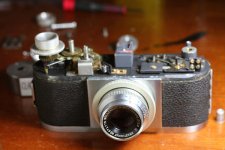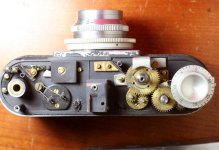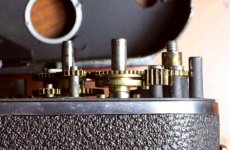tunalegs
Pretended Artist
What is the Clarus MS 35? A 1940s attempt to build a decent interchangeable lens, focal plane rangefinder camera in the U.S. Although usually regarded as a failure - the camera was in production for six years, and they're not all that rare, so certainly the camera enjoyed some success in the market. The other part of the failure equation is the design though. These cameras had a reputation for erratic to non-functional performance. The design is simple, but there are some "interesting" engineering choices in it.
On the whole the camera is substantially built. Outwardly the fit and finish look pretty good. The camera looks and feels solid. It is also unusually fat. Like Argus C3 fat. And it's weird and inexplicable given how little is actually inside the camera.
First thing I noticed looking under the hood - brass gears - brass bushings - brass bearings. No holding back on the brass for Clarus. The shutter spindles are substantial, the inside looks as big and heavy as the outside - well what little there is inside anyway.
Second thing I noticed was the four "drum" shutter. Not a Leica clone here. More in Common with an Exakta or Edixa SLR shutter. The primary advantage of this design is that shutter speeds can be selected before or after winding without damaging the shutter. However the designers of the Clarus built the shutter dial in such a way that you can't select shutter speeds until the the shutter is cocked, unless you're ok with not knowing what speed you're selecting.
Then something else struck me: The shutter curtains travel different distances. In cameras like the Exakta and Edixa the shutter rollers/drums are laid out so that the leading and following curtains travel nearly the same, if not precisely the same distance. This might be one reason for the Clarus erratic behavior.
This camera needed some cleaning and oil. I didn't want to remove the film gate since I didn't want to have to mess with collimating the lens. A nice thing is that the shutter axels all run through plates screwed into the camera, and this allowed me to peek around a little bit more.
After cleaning and oiling whatever was accessible without getting under the film gate, I began adjusting the shutter tension. First I let all the tension out, then I put on the minimum tension needed to get each curtain to pull fully through its travel. From there it was pretty simple to get a reliable 1/500 out of the shutter. So I tightened everything up, and put the camera together. Only to realize that somehow - the shutter got much faster when I put the camera together. 😱
It turned out that for some reason I don't fully understand, the retaining spring which holds the tension adjustment on the curtains, somehow had the effect of speeding up the shutter when tightened down. Took one full turn off each spring - checked again with the retaining spring fully tightened, and it looks acceptable again.
The shutter fires evenly and consistently at all speeds except 1/1000, which I didn't bother adjusting for.
Other odd design choices: the wind knob is smaller than the rewind knob. The shutter release works by un-meshing the shutter dial control gear from the film transport. When you lift your finger - a gear jams its way back into place to lock them together again (to rewind you hold the shutter button down). The camera body is super unnecessarily fat. The brushed chrome finish reminds me of 1980s soviet rangefinders. the camera is HEAVY beyond all belief really. The film door is cast metal. The top "plate" is cast as well.
On the whole the camera is substantially built. Outwardly the fit and finish look pretty good. The camera looks and feels solid. It is also unusually fat. Like Argus C3 fat. And it's weird and inexplicable given how little is actually inside the camera.
First thing I noticed looking under the hood - brass gears - brass bushings - brass bearings. No holding back on the brass for Clarus. The shutter spindles are substantial, the inside looks as big and heavy as the outside - well what little there is inside anyway.
Second thing I noticed was the four "drum" shutter. Not a Leica clone here. More in Common with an Exakta or Edixa SLR shutter. The primary advantage of this design is that shutter speeds can be selected before or after winding without damaging the shutter. However the designers of the Clarus built the shutter dial in such a way that you can't select shutter speeds until the the shutter is cocked, unless you're ok with not knowing what speed you're selecting.
Then something else struck me: The shutter curtains travel different distances. In cameras like the Exakta and Edixa the shutter rollers/drums are laid out so that the leading and following curtains travel nearly the same, if not precisely the same distance. This might be one reason for the Clarus erratic behavior.
This camera needed some cleaning and oil. I didn't want to remove the film gate since I didn't want to have to mess with collimating the lens. A nice thing is that the shutter axels all run through plates screwed into the camera, and this allowed me to peek around a little bit more.
After cleaning and oiling whatever was accessible without getting under the film gate, I began adjusting the shutter tension. First I let all the tension out, then I put on the minimum tension needed to get each curtain to pull fully through its travel. From there it was pretty simple to get a reliable 1/500 out of the shutter. So I tightened everything up, and put the camera together. Only to realize that somehow - the shutter got much faster when I put the camera together. 😱
It turned out that for some reason I don't fully understand, the retaining spring which holds the tension adjustment on the curtains, somehow had the effect of speeding up the shutter when tightened down. Took one full turn off each spring - checked again with the retaining spring fully tightened, and it looks acceptable again.
The shutter fires evenly and consistently at all speeds except 1/1000, which I didn't bother adjusting for.
Other odd design choices: the wind knob is smaller than the rewind knob. The shutter release works by un-meshing the shutter dial control gear from the film transport. When you lift your finger - a gear jams its way back into place to lock them together again (to rewind you hold the shutter button down). The camera body is super unnecessarily fat. The brushed chrome finish reminds me of 1980s soviet rangefinders. the camera is HEAVY beyond all belief really. The film door is cast metal. The top "plate" is cast as well.




